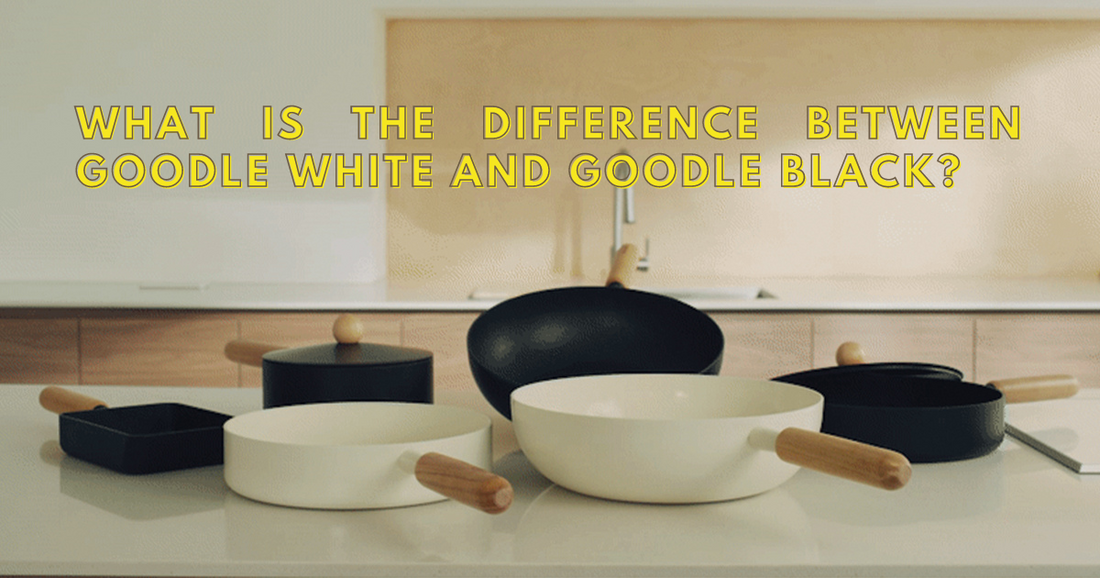Colour aside, one of the most significant differences between Goodle White and Goodle Black is the coating used in both series.

Goodle Coating: Teflon vs. Ceramic
Both coatings have their own unique benefits and drawbacks, and choosing the right one for your needs can make a big difference in your cooking experience.

Goodle Black : Teflon Coating (Inoble Oil Channel Method)
Teflon is a type of nonstick coating that is commonly used on cookware.

It's made from a synthetic material called polytetrafluoroethylene (PTFE) and is applied using the Inoble Oil Channel Method, which creates a more durable and longer-lasting coating. The Inoble Oil Channel method involves infusing the Teflon with oils, allowing it to better adhere to the cookware's surface and reduce the likelihood of scratching or peeling.
The benefits of Teflon coating include:
| ✔ Nonstick surface | Teflon creates a smooth and nonstick surface that makes cooking and cleaning a breeze. |
| ✔ Scratch-resistant | With the Inoble Oil Channel method, Teflon coating is more resistant to scratching and peeling than traditional Teflon coatings. |
| ✔ Heat-resistant | Teflon can withstand high temperatures, making it a good choice for cooking various dishes. |
Goodle White: Ceramic Coating
Ceramics is another popular type of nonstick coating that is made from a mixture of inorganic minerals, including silicon and oxygen.

It's applied using a process called sol-gel, which involves creating a liquid solution that is then applied to the cookware's surface and cured at high temperatures.
The benefits of ceramic coating include:
| ✔ Nonstick surface | Like Teflon, ceramic creates a nonstick surface that makes cooking and cleaning easier. |
| ✔ Versatility | Ceramic coatings can be used on various cookware materials, including stainless steel and aluminium. |
| ✔ Heat-resistant | Ceramics can withstand high temperatures, making it a good choice for cooking various dishes. |
Ceramic Coated and Teflon coating safe on cookware ?
The short answer is Yes.
Ceramic-coated cookware on the market can be free of PTFE and PFOA, but it depends on the specific brand and manufacturer. Always check the label or product directions to confirm that the ceramic coating is indeed PTFE and PFOA-free.
Some unknown brands of cookware that use Teflon coatings, might contain polytetrafluoroethylene. However, reputable brands and manufacturers have taken steps to ensure their Teflon coatings are safe and free of harmful chemicals, including PFOA. The Inoble Oil Channel method of applying a PTFE coating is an example of a process that creates a safer, more durable nonstick surface while reducing the potential for chemical release during use.
How should I choose between these two?

Choose simplicity based on your culinary needs. If you like to cook a lot of Chinese food, pan fry and stir fry food, or love the smoky flavour ''wok hei'' resulting from stir-frying foods over an open flame in Cantonese cuisine. Choose goodle black.
If you're not specially requested on that ''wok hei'', then choose according to your favourite colour will do :)
For Modori, we design and manufacture our cookware with each individual's health in mind.
Both of our Modori Goodle Collection use a special Inoble Coating, a patented oil road method which enhances the non-stick effect and makes it easier to clean after use. and it's free from PFOA and harmful substances.

It is important to note that using any type of nonstick cookware requires a certain level of care and attention to ensure safe use.
For example, using high heat on nonstick cookware can damage the nonstick coating, or worse, potentially release harmful chemicals, even with PTFE- and PFOA-free coatings.
It is recommended to follow the manufacturer's directions and use low to medium heat when cooking with nonstick cookware to minimize any potential risks and reduce the chance of damaging the coating.



